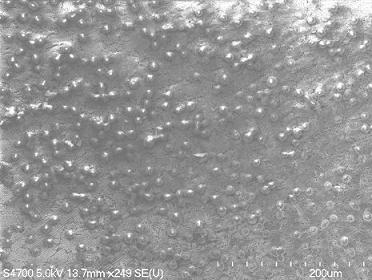Home > Press > Nanotubes that Heal: Engineering Better Orthopedic Implants
 |
| Fibroblasts growing on titanium alloy coated with nanotubes |
Abstract:
Titanium and its alloys have a leg up on all other materials used to make the orthopedic implants used by surgeons to repair damaged bones and joints. They are light, super-strong, and virtually inert inside the body. But whether the implants are destined for your knee, your hip, your spine or your jaw, the silvery metal has one big drawback.
By Marcia Goodrich
Nanotubes that Heal: Engineering Better Orthopedic Implants
Houghton, MI | Posted on May 19th, 2010"Titanium has a mirror surface," says Tolou Shokufar, a PhD candidate in mechanical engineering-engineering mechanics. Cells don't adhere to it very well, so implants are often roughened up before they are placed in the body.
A good way to roughen titanium is to etch nanotubes into it, since they provide a superb surface for bone cells to grasp onto as part of the healing process. But etching nanotubes in the titanium alloy preferred by surgeons is not cheap. Conventional techniques require platinum, which costs over $1,700 an ounce.
Through her PhD work with Professor Craig Friedrich, director of the Multi-scale Technologies Institute, Shokufar has developed a less expensive way to etch nanotubes into the titanium alloy. In a weak solution of ammonium fluoride, she immerses two rods, one of the alloy, another of copper, and hooks them up to a power source. An electrical current flows into the copper, through the solution and out the titanium.
"It corrodes the titanium dioxide layer on the titanium in the form of a tube," Shokufar says, making nanotubes about seven microns long and a hundred nanometers in diameter. Growing the ideal tube takes about two hours.
Then she applies heat and pressure to the titanium alloy, annealing the nanotubes to give them a hydrophilic, crystalline structure. The surface not only attracts water, tests show it provides a friendly place for cells to grow. Shokufar has conducted experiments with fibroblasts—cells that make scar tissue—showing they grow faster on a layer of her titanium dioxide nanotubes than on the unaltered surface of the titanium alloy. Next, she aims to do a similar experiment with bone-growing osteoblasts.
Because the nanotubes are chemically identical to the titanium alloy, Shokufar expects that her innovation could be approved for medical use with relative ease. It may also have a wide variety of other applications, ranging from drug delivery to solar cells to hydrogen generation.
Her technique seems simple, but it didn't start out that way. "It took a lot of time to figure out," she says. "I'd spend days and days under the SEM, and when I went to sleep, I saw nanotubes inside my eyelids."
It's been worth it to see the perfect sheets of nanotubes grow under her care, however. "I really like them," she says. "They are like my babies."
####
About Michigan Technological University
Michigan Technological University (mtu.edu) is a leading public research university developing new technologies and preparing students to create the future for a prosperous and sustainable world. Michigan Tech offers more than 130 undergraduate and graduate degree programs in engineering; forest resources; computing; technology; business; economics; natural, physical and environmental sciences; arts; humanities; and social sciences.
For more information, please click here
Contacts:
Marcia Goodrich
906-487-2343
Copyright © Michigan Technological University
If you have a comment, please Contact us.Issuers of news releases, not 7th Wave, Inc. or Nanotechnology Now, are solely responsible for the accuracy of the content.
| Related News Press |
News and information
![]() Researchers develop molecular qubits that communicate at telecom frequencies October 3rd, 2025
Researchers develop molecular qubits that communicate at telecom frequencies October 3rd, 2025
![]() Next-generation quantum communication October 3rd, 2025
Next-generation quantum communication October 3rd, 2025
![]() "Nanoreactor" cage uses visible light for catalytic and ultra-selective cross-cycloadditions October 3rd, 2025
"Nanoreactor" cage uses visible light for catalytic and ultra-selective cross-cycloadditions October 3rd, 2025
Possible Futures
![]() Spinel-type sulfide semiconductors to operate the next-generation LEDs and solar cells For solar-cell absorbers and green-LED source October 3rd, 2025
Spinel-type sulfide semiconductors to operate the next-generation LEDs and solar cells For solar-cell absorbers and green-LED source October 3rd, 2025
Nanotubes/Buckyballs/Fullerenes/Nanorods/Nanostrings
![]() Enhancing power factor of p- and n-type single-walled carbon nanotubes April 25th, 2025
Enhancing power factor of p- and n-type single-walled carbon nanotubes April 25th, 2025
![]() Chainmail-like material could be the future of armor: First 2D mechanically interlocked polymer exhibits exceptional flexibility and strength January 17th, 2025
Chainmail-like material could be the future of armor: First 2D mechanically interlocked polymer exhibits exceptional flexibility and strength January 17th, 2025
![]() Innovative biomimetic superhydrophobic coating combines repair and buffering properties for superior anti-erosion December 13th, 2024
Innovative biomimetic superhydrophobic coating combines repair and buffering properties for superior anti-erosion December 13th, 2024
Nanomedicine
![]() New molecular technology targets tumors and simultaneously silences two ‘undruggable’ cancer genes August 8th, 2025
New molecular technology targets tumors and simultaneously silences two ‘undruggable’ cancer genes August 8th, 2025
![]() New imaging approach transforms study of bacterial biofilms August 8th, 2025
New imaging approach transforms study of bacterial biofilms August 8th, 2025
![]() Cambridge chemists discover simple way to build bigger molecules – one carbon at a time June 6th, 2025
Cambridge chemists discover simple way to build bigger molecules – one carbon at a time June 6th, 2025
![]() Electrifying results shed light on graphene foam as a potential material for lab grown cartilage June 6th, 2025
Electrifying results shed light on graphene foam as a potential material for lab grown cartilage June 6th, 2025
|
|
||
|
|
||
| The latest news from around the world, FREE | ||
|
|
||
|
|
||
| Premium Products | ||
|
|
||
|
Only the news you want to read!
Learn More |
||
|
|
||
|
Full-service, expert consulting
Learn More |
||
|
|
||








